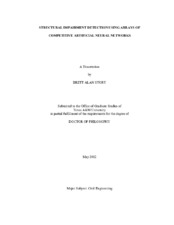| dc.description.abstract | Aging railroad bridge infrastructure is subject to increasingly higher demands such as heavier loads, increased speed, and increased frequency of traffic. The challenges facing railroad bridge infrastructure provide an opportunity to develop improved systems of monitoring railroad bridges. This dissertation outlines the development and implementation of a Structural Impairment Detection System (SIDS) that incorporates finite element modeling and instrumentation of a testbed structure, neural algorithm development, and the integration of data acquisition and impairment detection tools. Ultimately, data streams from the Salmon Bay Bridge are autonomously recorded and interrogated by competitive arrays of artificial neural networks for patterns indicative of specific structural impairments.
Heel trunnion bascule bridges experience significant stress ranges in critical truss members. Finite element modeling of the Salmon Bay Bridge testbed provided an estimate of nominal structural behavior and indicated types and locations of possible impairments. Analytical modeling was initially performed in SAP2000 and then refined with ABAQUS. Modeling results from the Salmon Bay Bridge were used to determine measureable quantities sensitive to modeled impairments. An instrumentation scheme was designed and installed on the testbed to record these diagnostically significant data streams. Analytical results revealed that main chord members and bracing members of the counterweight truss are sensitive to modeled structural impairments. Finite element models and experimental observations indicated maximum stress ranges of approximately 22 ksi on main chord members of the counterweight truss.
A competitive neural algorithm was developed to examine analytical and experimental data streams. Analytical data streams served as training vectors for training arrays of competitive neural networks. A quasi static array of neural networks was developed to provide an indication of the operating condition at specific intervals of the bridge's operation. Competitive neural algorithms correctly classified 94% of simulated data streams. Finally, a stand-alone application was integrated with the Salmon Bay Bridge data acquisition system to autonomously analyze recorded data streams and produce bridge condition reports. Based on neural algorithms trained on modeled impairments, the Salmon Bay Bridge operates in a manner most resembling one of two operating conditions: 1) unimpaired, or 2) impaired embedded member at the southeast corner of the counterweight. | en |


